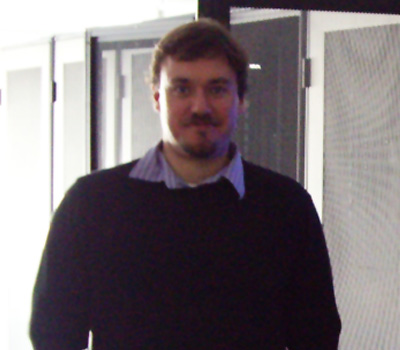Understanding where planets come from and if habitable life elsewhere is possible
For centuries, astronomers have pondered how our planet was formed and how life came to be. Due to the large and challenging nature of these questions, it will take a long time and many people to properly answer them. However, journeys are composed of small steps and researchers today are taking some of these first steps towards understanding our universe. Dr. Brad Hansen, of the University of California, Los Angeles, hopes to understand how and where planets form, and what determines the conditions on a given planet. Using both theory, large scale computation and observation, Dr. Hansen's holistic approach to understanding planets holds promise for exciting and innovative findings. Therefore, through the desire to find and characterize planets around other stars, we will have a better perspective of our place in the Universe.
Dr. Hansen's work to combine both observational and theoretical techniques helps to provide a comprehensive analysis of the planet formation problem. More specifically, Dr. Hansen's work may address genuine scientific questions as to how to put our solar system into the context of the other solar systems. We now know of many planetary systems that do not look like ours and placing our own solar system within this broader framework can explain how habitable planets come about and what conditions are necessary for this to happen. Dr. Hansen's research offers a context for whether other life-bearing planets like Earth can exist. With this lens, Dr. Hansen's research embraces the idea that it is necessary to combine both theoretical and observational techniques if researchers wish to understand the complexity and diversity of planets in our Galaxy!
Current research includes:
-
Origins of Multi Planet Systems: Dr. Hansen is trying to interpret observations of stars that are orbited by multiple planets to understand what physical principles determine how many planets form around a particular star and their space ratio. This involves computer modelling and simulation of planetary assembly under various conditions and then comparing with the observed properties.
-
Long-term Stability: Dr. Hansen hopes to understand the long-term stability of planetary systems. In our own solar system, the gravitational perturbations of Jupiter and Saturn affect the planets like Earth, Venus and particularly Mercury. There are other stars which also host some combination of giant planets and rocky planets, and Dr. Hansen and his team are trying to understand how the two groups interact to determine the long term stability and habitability of the Earth-like planets.
-
Planetary Transits: Dr. Hansen and his team are also conducting observations of planets that pass in front of their host stars. By using the Keck telescope, Dr. Hansen and his students take spectra of these planets to try and characterise the chemical composition of the atmosphere. The techniques they are developing will hopefully one day allow them to measure the atmospheric composition of earth-like planets to understand whether they contain sufficient oxygen or water to be considered habitable.
Bio
Dr. Hansen was born and raised in South Africa and has always enjoyed solving problems. The notion of measuring and quantifying the world is natural to him and he finds research to be intellectually stimulating. The search for other planets and especially life-bearing planets, is one of the grand intellectual challenges of the 21st century and he finds it very exciting to be a part of it. Aside from research, Dr. Hansen enjoys playing soccer, is a member of the Academy of Magical Arts in Hollywood, and loves to spend time with his wife and two young sons. A fan of midcentury modern architecture, Dr Hansen resides in one of the few Eichler homes in Los Angeles County.
Dr. Hansen's team currently consists of one graduate student who is working on numerical simulations of planetary dynamics, an NSF postdoctoral fellow that focuses on the interaction of gravitational and atmospheric dynamics of planets, and an undergraduate student. Dr. Hansen also continues to work with an undergraduate student that is now a graduate student at Cal State Northridge and a former graduate student that is now a postdoctoral fellow at the University of Arizona on the project to observe planetary transits. Lastly, Dr. Hansen maintains a collaboration with a professor at Arizona who provides atmospheric models to compare to our observations, and with a professor at the University of Toronto, on the dynamical simulations of planet formation.
Website: http://www.astro.ucla.edu/~hansen


